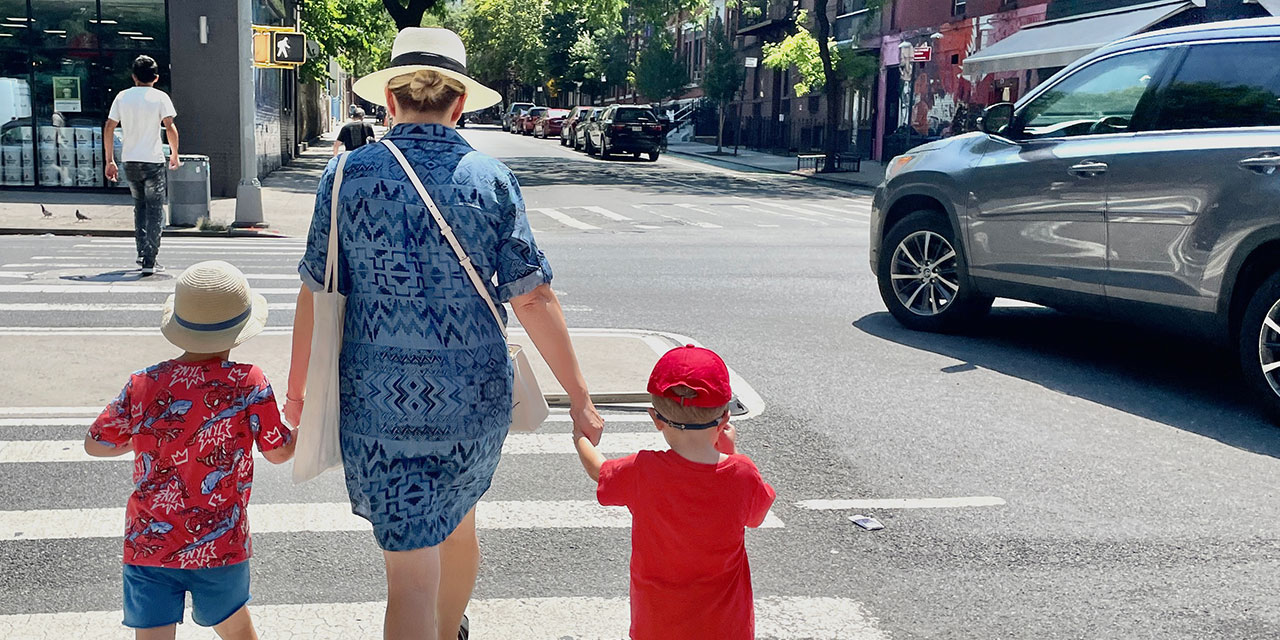
New York has always tested parents’ endurance, but today they face a new burden: chronic unpredictability. Some families can budget for “expensive,” but not for a sudden tuition spike, a daycare closure announced by email at 10 p.m., or a school-lottery assignment that upends a carefully planned commute. Shocks like these can push even the most diehard city loyalists to start browsing Zillow for homes in New Jersey or Long Island.
The numbers reflect the rising pressures on New York families. Between 2020 and 2023, the city lost nearly 92,000 children under five—17 percent of that population—even as the adult population grew. Costs are doubtless a big part of the reason. The median market-rate for a rental is about $3,700 a month, up about 30 percent since 2019. An infant slot in a licensed daycare center averages $2,167 a month, up 23 percent since 2019. For middle-income households, the math increasingly does not work: the median income of families with children under five who left the city was $140,000.
Finally, a reason to check your email.
Sign up for our free newsletter today.
City Hall cannot wish away New York’s cost structure, but it can attack its volatility. Doing so will help keep young families in the city so that their children can grow into happy—and taxpaying—residents.
Past administrations’ attempts to ease childcare burdens have failed to offer families enough value to justify staying in the city. Pre-K and 3-K have expanded access for three- and four-year-olds, offering parents meaningful—if uneven—relief. But these programs have also distorted the market for younger children. Center owners, constrained by staffing and space, chase better-funded public contracts. Prices for infant and toddler care soar, leaving middle-income parents in a no man’s land: ineligible for vouchers, yet unable to afford care out of pocket. Albany’s decision to expand voucher eligibility without providing dedicated funding resulted in uncertainty over frozen enrollments. The city came up with the money to continue providing vouchers to eligible families, but as of now, there is no permanent source of funding at either the state or city level.
Urban economists have long noted that households can tolerate high prices—so long as variance is low. A guaranteed public-school seat brings stability to childcare planning and promotes predictability. New York City’s enrollment system does the opposite: it layers random lotteries and budget uncertainty atop the nation’s highest costs. Eliminating that unpredictability would be a cheaper and fairer alternative to ever-larger subsidies, helping low- and middle-income families alike rather than pitting them against the poorest.
If the next mayor wants to tackle this volatility, he or she should take these four steps.
First, guarantee stable funding for New York’s childcare vouchers. These supplement other benefits and keep the poorest parents in the labor force, supporting a network of small providers that employ tens of thousands of mostly female workers, especially in Orthodox Jewish, black, and Hispanic neighborhoods, where most of New York’s children reside.
Meantime, households in the same communities earning over $90,000 for a family of three get little to no support, while paying full market rates for childcare. For them, this isn’t just a cost problem; it’s a cash-flow one. Rent and tuition come due at the same time. Tax credits don’t help much if the real squeeze happens in July.
That’s why New York should redirect underutilized 3-K funds to pilot a modest, income-adjusted monthly direct-cash allowance for lower-middle-class families during the first year of a child’s life, before the tax credits kick in. The funds could be used for licensed care or a certified sitter—whatever best suits the parents’ needs.
Second, the next mayor should create a fingerprinting and certification system for caregivers to enhance safety, in collaboration with the state. Queensland, Australia, issues a “Blue Card” to anyone who passes background checks to work with children. New York could adopt a similar “Blue Badge,” embedded in the existing IDNYC card. A quick QR scan would verify that a babysitter, nanny-share partner, or pod teacher has cleared fingerprinting and completed a short child-safety course. Parents would gain peace of mind; caregivers, a portable credential; and the city might draw a large gray market into the regulated (and taxable) economy, especially if Blue Badge holders become eligible to accept voucher payments. For licensed care centers, this would reduce a layer of hiring bureaucracy.
Third, the next mayor should build more housing and push for zoning changes that would allow daycare facilities to operate in more locations, especially near transit. Housing costs are highly correlated with childcare costs, so increasing supply would likely lower the prices of both.
New York City currently requires childcare centers to be located on the ground floor and to provide on-site outdoor space, unless they secure a waiver—a process often plagued by delays. By contrast, London allows nearby public parks to meet outdoor space requirements with minimal paperwork, and Paris permits upper-floor centers if they comply with fire safety codes. New York should review its regulations for unnecessary compliance burdens. Streamlining park-use approvals, allowing upper-floor centers with appropriate safeguards, and offering zoning bonuses for childcare space near subways—especially in high-demand neighborhoods—would expand access and bring the city in line with more flexible international models.
Finally, the next mayor should guarantee after-school programs in every public school. The 2:30–6:00 p.m. gap poses a major financial and logistical challenge for parents working full-time. Existing contracts with overstretched after-school nonprofits often don’t begin until weeks after the school year starts, and programs struggle with staffing shortages and bureaucratic delays.
A better solution is to staff programs with paraprofessionals, school aides, and local artists—already vetted by the Department of Education and paid hourly—working inside the buildings they know. Parents could opt into additional enrichment offerings, but the core program should be as dependable as the school day itself and potentially extend into July and August. That would eliminate parental reliance on the current patchwork of camps, relatives, and improvisation. Implementation would require negotiations with the United Federation of Teachers and District Council 37. Funding could come from school consolidations, reduced administrative staffing, and reallocating resources from schools with declining enrollments.
Parents should also have the right to decide whether a middle or high schooler is mature enough to walk a younger sibling home—especially from K–8 schools. This simple change could immediately reduce the need for paid care, lowering costs for many families.
If New York’s next mayor promotes predictability in public education, the city can offer something the suburbs never will: a dense, diverse, opportunity-rich childhood—without the parental panic that’s pushing the middle class to leave.
Photo by: Deb Cohn-Orbach/UCG/Universal Images Group via Getty Images
Source link

















